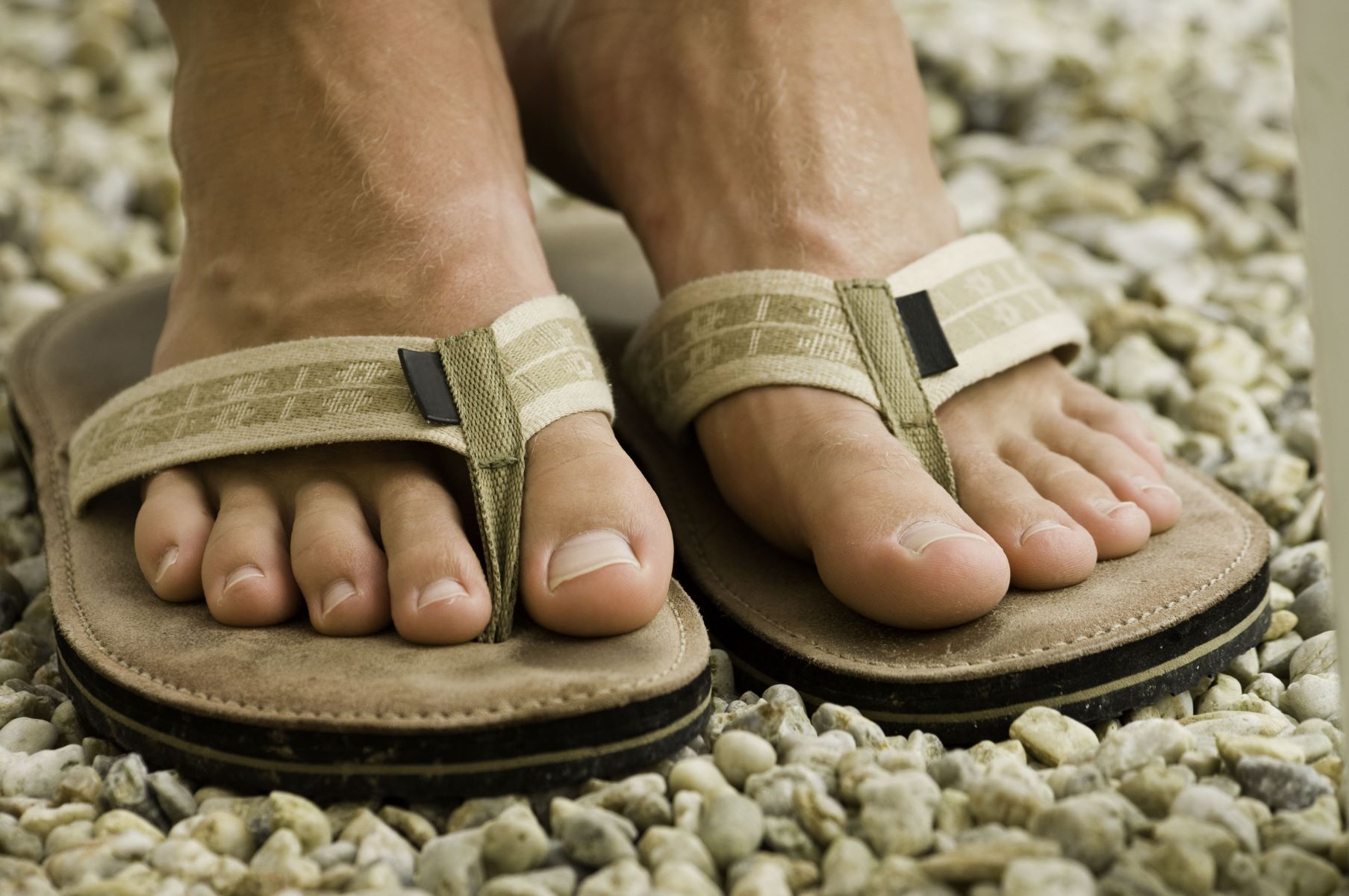Home>Health and Wellness>The Shocking Truth: Flip Flops And Plantar Fasciitis


Health and Wellness
The Shocking Truth: Flip Flops And Plantar Fasciitis
Published: February 5, 2024
Discover the surprising connection between flip flops and plantar fasciitis. Learn how to protect your feet and improve your health with our health and wellness tips.
(Many of the links in this article redirect to a specific reviewed product. Your purchase of these products through affiliate links helps to generate commission for Regretless.com, at no extra cost. Learn more)
Table of Contents
Introduction
Picture this: a warm, sunny day, and you're excited to slip on your favorite pair of flip flops for a leisurely stroll. The carefree, laid-back vibe of flip flops makes them a popular choice for many, especially during the summer months. However, what if I told you that these seemingly innocent and comfortable footwear choices could be contributing to a common and often debilitating foot condition known as plantar fasciitis?
Plantar fasciitis is a condition that causes intense heel pain, particularly during the first steps in the morning or after prolonged periods of sitting or standing. It occurs when the plantar fascia, a thick band of tissue that runs across the bottom of your foot, becomes inflamed or irritated. This discomfort can significantly impact one's quality of life, making even simple activities like walking a painful ordeal.
In this article, we'll delve into the surprising connection between flip flops and plantar fasciitis. We'll explore how the design and lack of support in flip flops can exacerbate this condition, shedding light on the potential risks they pose to foot health. Furthermore, we'll provide valuable insights into choosing footwear that promotes foot health and minimizes the risk of developing or worsening plantar fasciitis. So, before you slip on those flip flops for your next adventure, let's uncover the truth about their impact on your precious feet.
Read more: How To Flip Houses With No Money
What is Plantar Fasciitis?
Plantar fasciitis is a prevalent and often persistent foot condition characterized by sharp, stabbing pain in the heel. This discomfort typically occurs during the first steps in the morning or after prolonged periods of sitting or standing. The plantar fascia, a thick band of tissue that spans the bottom of the foot, connects the heel bone to the toes and supports the arch of the foot. When this tissue becomes inflamed or irritated, it leads to the development of plantar fasciitis.
The primary role of the plantar fascia is to absorb the high levels of stress and strain that the foot experiences during physical activities like walking, running, or standing. However, factors such as excessive strain, overuse, or repetitive stress can lead to small tears in the fascia, resulting in inflammation and heel pain. Additionally, certain risk factors, including obesity, high-impact activities, inadequate footwear, and foot mechanics issues, can contribute to the development of plantar fasciitis.
The hallmark symptom of plantar fasciitis is a sharp, stabbing pain in the heel, particularly near the bottom of the foot. This discomfort can make walking or standing excruciating, impacting one's mobility and overall quality of life. Moreover, the pain associated with plantar fasciitis can be more intense after prolonged periods of inactivity, such as sitting or sleeping, as the plantar fascia tightens during these times.
Plantar fasciitis is a condition that can persist for an extended period if left untreated, significantly affecting an individual's daily activities and overall well-being. Therefore, understanding the causes, symptoms, and potential risk factors of plantar fasciitis is crucial for early detection and effective management of this debilitating foot ailment.
In the following sections, we will delve into the relationship between flip flops and plantar fasciitis, shedding light on how certain footwear choices can impact foot health and contribute to the development or exacerbation of this condition. Understanding these connections will empower individuals to make informed decisions about their footwear, ultimately promoting better foot health and reducing the risk of plantar fasciitis.
The Link Between Flip Flops and Plantar Fasciitis
Flip flops, with their minimalistic design and effortless style, are a go-to choice for many seeking comfort and convenience, especially in warm weather. However, the very features that make flip flops popular also contribute to their potential link to plantar fasciitis. Understanding this connection is crucial for individuals looking to safeguard their foot health and minimize the risk of developing or exacerbating this painful condition.
The primary concern with flip flops lies in their lack of arch support and cushioning. Unlike supportive athletic shoes or well-structured sandals, flip flops offer minimal to no arch support, leaving the foot vulnerable to strain and stress. This absence of adequate support can lead to overpronation, a biomechanical issue where the foot rolls inward excessively, placing excessive strain on the plantar fascia. Over time, this strain can lead to inflammation and irritation of the plantar fascia, contributing to the onset or worsening of plantar fasciitis.
Furthermore, the thin, flat sole of flip flops fails to absorb the impact and shock that the foot endures during walking or other weight-bearing activities. As a result, the plantar fascia is subjected to increased stress and pressure with each step, further aggravating the condition. Additionally, the lack of a secure heel strap in most flip flops can cause the toes to grip the footwear tightly to keep it in place, leading to an unnatural gait and altered biomechanics that can strain the plantar fascia.
Moreover, the inherent design of flip flops encourages the foot to splay and spread with each step, which can contribute to instability and altered foot mechanics. This can lead to an uneven distribution of weight and pressure on the foot, potentially exacerbating existing foot issues or creating an environment conducive to the development of plantar fasciitis.
In essence, the combination of minimal arch support, inadequate shock absorption, and the design of flip flops can place undue stress on the plantar fascia, making them a potential contributing factor to the development or aggravation of plantar fasciitis. By understanding these implications, individuals can make informed choices about their footwear, prioritizing options that offer proper support and cushioning to promote optimal foot health and reduce the risk of plantar fasciitis.
Impact of Flip Flops on Foot Health
The impact of flip flops on foot health extends beyond mere comfort and convenience, delving into the realm of biomechanics and potential long-term implications for the feet. While these airy and lightweight sandals may be the footwear of choice for many, it's essential to recognize their potential effects on foot health, particularly concerning conditions like plantar fasciitis.
Lack of Support and Stability
One of the primary concerns regarding flip flops is their minimalistic design, which often translates to inadequate arch support and cushioning. Unlike supportive athletic shoes or sandals with contoured footbeds, flip flops offer little to no support for the arch of the foot. This lack of support can lead to overpronation, a biomechanical issue where the foot rolls inward excessively, placing strain on the plantar fascia. Over time, this strain can contribute to inflammation and irritation, potentially exacerbating or precipitating plantar fasciitis.
Insufficient Shock Absorption
The thin, flat sole of flip flops fails to provide adequate shock absorption, leaving the foot vulnerable to the impact and stress of walking or standing. With each step, the plantar fascia is subjected to increased stress and pressure, which can contribute to the development or worsening of plantar fasciitis. The absence of cushioning also means that the foot may not be adequately protected from the hard surfaces it comes into contact with, further increasing the risk of foot discomfort and potential injury.
Altered Biomechanics
The design of flip flops, characterized by the absence of a secure heel strap and the encouragement of a splaying motion with each step, can lead to altered foot mechanics. The lack of a secure heel strap may cause individuals to grip the footwear tightly with their toes to keep it in place, leading to an unnatural gait and potential strain on the plantar fascia. Additionally, the splaying motion encouraged by flip flops can contribute to instability and an uneven distribution of weight and pressure on the foot, potentially creating an environment conducive to foot issues like plantar fasciitis.
Risk of Trips and Falls
Beyond the biomechanical implications, flip flops also pose a risk of trips and falls due to their inherent design. The lack of a secure heel strap and the minimal coverage of the foot can lead to an increased risk of slipping or tripping, potentially resulting in foot injuries or exacerbating existing foot conditions.
In summary, the impact of flip flops on foot health encompasses a range of concerns, from inadequate support and shock absorption to the potential for altered foot mechanics and an increased risk of trips and falls. Recognizing these implications empowers individuals to make informed choices about their footwear, prioritizing options that offer proper support and cushioning to promote optimal foot health and reduce the risk of conditions like plantar fasciitis.
Tips for Choosing Footwear
When it comes to selecting footwear that promotes foot health and minimizes the risk of conditions like plantar fasciitis, several key considerations should guide your decision-making process. By prioritizing certain features and characteristics, you can make informed choices that support the well-being of your feet and overall musculoskeletal health.
Read more: The Shocking Truth About “Hella” In The US
1. Arch Support
Opt for footwear that provides adequate arch support, helping to distribute weight evenly and reduce the strain on the plantar fascia. Look for shoes with contoured footbeds or built-in arch support to maintain the natural alignment of the foot and minimize the risk of overpronation.
2. Cushioning
Choose shoes with ample cushioning to absorb the impact and shock of walking or standing. Proper cushioning can help protect the plantar fascia and minimize the stress placed on the foot during weight-bearing activities.
3. Stability and Motion Control
Prioritize footwear that offers stability and motion control, particularly if you have a history of foot issues or biomechanical imbalances. Look for features such as a secure heel strap, firm heel counters, and structured soles to promote a stable and controlled gait.
4. Toe Box Space
Ensure that the toe box provides ample space for the toes to splay naturally without feeling constricted. A roomy toe box can prevent the development of foot issues and enhance overall comfort, especially during prolonged periods of standing or walking.
5. Material Quality
Consider the materials used in the construction of the footwear. Opt for high-quality, breathable materials that allow for proper ventilation and moisture management, reducing the risk of discomfort or skin irritations.
6. Proper Fit
Always prioritize the proper fit when selecting footwear. Ensure that there is adequate room for the toes to move freely without being cramped, and that the shoes provide ample support and stability without causing pressure points or friction.
7. Activity-Specific Footwear
Choose footwear that is appropriate for the intended activity. Whether it's walking, running, or casual wear, select shoes designed to support the specific demands of the activity, providing the necessary cushioning, support, and protection.
8. Regular Footwear Assessment
Periodically assess the condition of your footwear and replace worn-out or unsupportive shoes. Over time, the cushioning and support in footwear can deteriorate, compromising their ability to protect and support the feet effectively.
By incorporating these tips into your footwear selection process, you can prioritize foot health and reduce the risk of conditions like plantar fasciitis. Remember that investing in supportive and well-designed footwear is an investment in the long-term well-being of your feet and overall musculoskeletal health.
Read more: Fish Without Scales: The Shocking Truth!
Conclusion
In conclusion, the relationship between flip flops and plantar fasciitis unveils crucial insights into the impact of footwear choices on foot health. The minimalistic design of flip flops, characterized by inadequate arch support, limited cushioning, and the absence of secure heel straps, can contribute to altered foot mechanics, increased stress on the plantar fascia, and a heightened risk of developing or exacerbating plantar fasciitis. Understanding these implications empowers individuals to make informed decisions about their footwear, prioritizing options that offer proper support and cushioning to promote optimal foot health and reduce the risk of foot conditions.
As we navigate the myriad of footwear options available, it is essential to prioritize features such as arch support, cushioning, stability, and proper fit. By choosing footwear that aligns with these criteria, individuals can minimize the risk of foot issues and support the overall well-being of their feet. Additionally, recognizing the potential impact of flip flops on foot health underscores the importance of regular footwear assessment and the need to replace worn-out or unsupportive shoes to maintain optimal foot support and protection.
Ultimately, the connection between flip flops and plantar fasciitis serves as a reminder of the intricate relationship between footwear choices and foot health. By embracing informed decision-making when it comes to selecting footwear, individuals can prioritize their foot health, reduce the risk of conditions like plantar fasciitis, and foster a supportive foundation for their overall musculoskeletal well-being. It is through these conscious choices that individuals can step confidently towards a future where foot comfort and health are upheld, allowing them to embrace each stride with ease and vitality.











